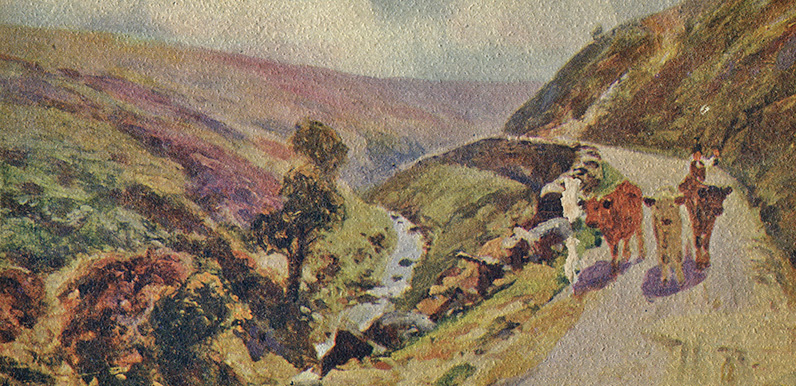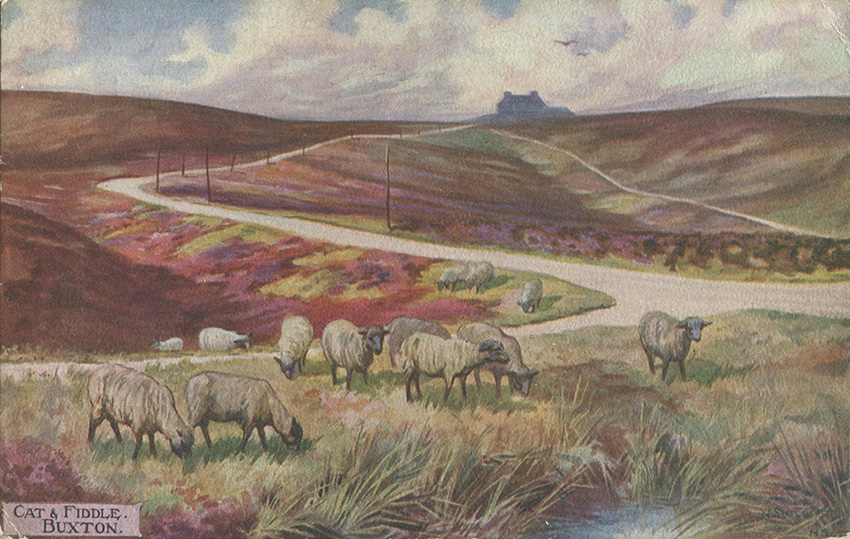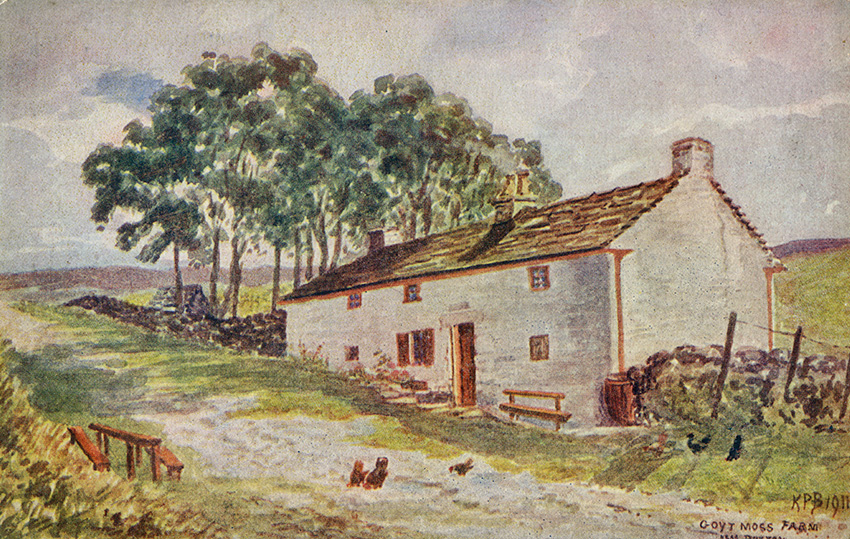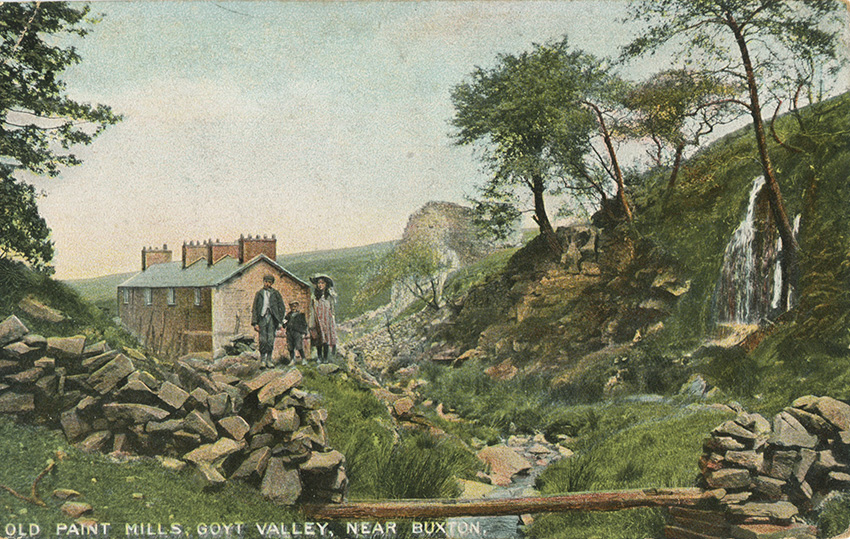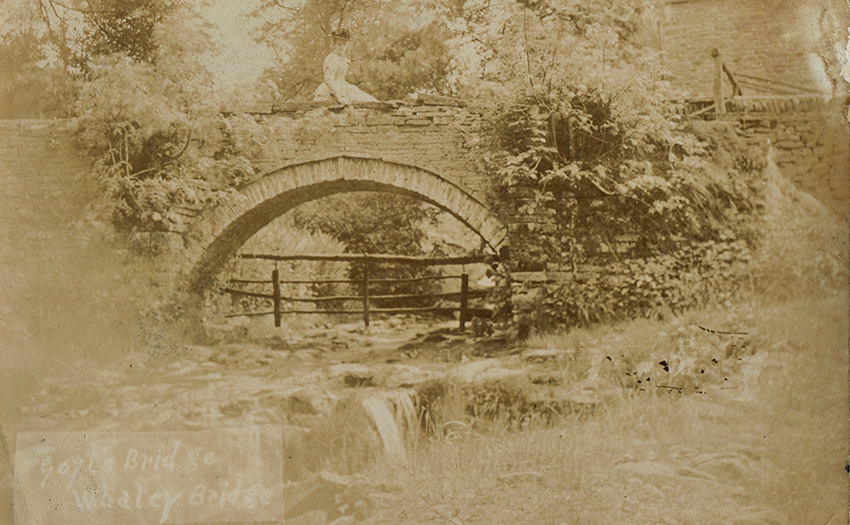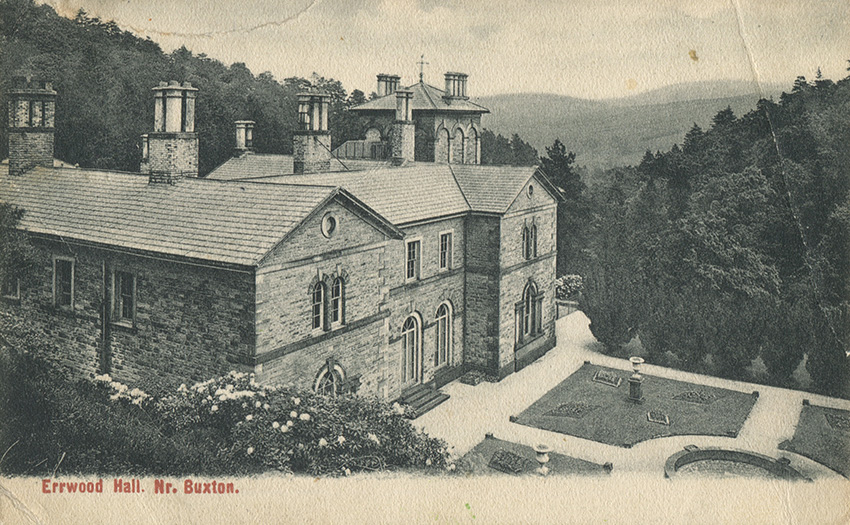The author mentions the small row of paint mill cottages which stood to the right of this view. Goytsclough Quarry was just behind.
Today, the old packhorse bridge spans the Goyt in the valley below. It was moved here from Goyt’s Bridge in the 1960s, shortly before Errwood Reservoir was flooded.
Starting from Buxton, the companions walked first to Burbage on the western edge of the town, before taking the old Macclesfield road to Goyt’s Moss. At Derbyshire Bridge, they turned right to visit Goyt’s Bridge and Errwood Hall, passing Goytsclough Quarry on their way.
(To anyone unfamiliar with the term ‘Shank’s mare’ – or ‘Shanks’s pony’ – it means to walk rather than ride. But I must admit that I’ve never come across the term ‘marrow-bone stage’. Perhaps it’s just another term for walking. If anyone can enlighten me, please get in touch.*)
This marrow-bone stage, tractioned as it is by Shank’s mare, has many conveniences and perhaps as many drawbacks. It is a pedestrian mode of conveyance, and although Dr. Samuel Johnson has left it on record that the vehicular mode is the more attractive, yet of the two we preferred our own turn-out.
After a brief halt at Burbage, a pleasantly-situated village, with a modern church of much beauty and an ancient inn of exceeding quaintness, we struck the old Macclesfield road skirting Axe Edge.
A curious highway this, and a steep and stony one withal. It is for the most part covered with grass, and comparatively unused. Down its precipitous declivities used aforetime to rattle the now obsolete stage coach, and many are the stirring tales of adventure which venerable Buxtonians can tell of it.
The old road drops down to Derbyshire Bridge and Goyt’s Moss. Today there’s a small car park and Rangers’ hut at Derbyshire Bridge.
Away up this rocky roadway we come upon rills which eventually make rivers. Among others were certain of the founts of the Goyt, which latter stream, with numerous tinkling tributaries, develops into the Mersey.
“The quality of Mersey is not strained,” said Mrs. Harriet Beecher Stowe, adapting the famous line from Portia’s immortal address, on first observing that noble stream from the deck of an Atlantic liner on her way up to Liverpool landing-stage. But here at its source it certainly is strained.
The water as it starts and steals from the bleak, bronzed moorland wastes is occasionally clear as crystal, and again of pale wine tint: whereas at Liverpool it is of the colour and consistency of pea soap. There is food for reflection – plenty of it – standing here or there at one or other of the cradles of the great river which bears upon its broad bosom the agonies of the world.
The picture is a pleasant one, and would make an effective canvas. This place is Goyt’s Moss, the kindly housewife tells us. Turning into Goyt’s Clough, banks of dark brown, almost black, shale border the stream for some distance, the water seemingly flowing along a bed of gold.
Then as bend after bend in the valley opens out, the slopes are bronzed with heather not yet in bloom, and vividly green the patches of robust bracken. In clefts and crannies near the edge of the stream flourish ferns of much beauty, and occasionally – so far as species are concerned – of great rarity.
Anon the valley, treeless at the commencement, becomes wonderfully well wooded. Fir and larch, pine and spruce, oak and elder, with here and there the large-leafed sycamore, the feathery silver birch, with poetic appropriateness known as ‘the lady of the woods’ and the mountain ash – the rowan tree of the Highlands – clothe the steep banks and impart a beauty, a grace, and a charm all their own.
He also mentions a ‘rusting and rotting wheel’ which he says was used to scour stone taken from Goytsclough Quarry. But if it was close to the cottages, I think it was more likely to be from Goytsclough Paint Mill.
These quarries, at one time supplied the stone for the paving of Regent Street. Near to the cottages is a rusting and rotting wheel, reputed to be the next largest in the world to that Lanxcy, in Manxland.
This mammoth turbine in Goyt’s Clough is understood to have been used for the scouring of the stone, and it appears that the flags were conveyed by pack horse to Leek, through which ran the nearest highway to London. Pickford was a native of King Sterndale, and his descendants still live there in what has been described as “A house smothered in trees that are an artist’s dream of colour.”
“He who has seen Derbyshire has no need to visit the Highlands,” remarked Dr. Johnson’s Scotch biographer, speaking at Dovedale. Still more just, still more applicable would have been the observation had it been made in connection with the valley of the Goyt. It is for all the world like a wild Highland glen, both in its conformation and its trees, verdure, and brawling waters.
This is one of the oldest photos I have of the bridge (click to enlarge), and would have been taken around the time our two companions passed this way on their way to Errwood Hall.
“There is a grey farmhouse, and here and there the blue film rises from a cottage mixed up in dark patches of pine and fir. A solitary arch of lichened stone spans the little voiceful river, which, rising from Axe Edge – the great watershed of the Peak district-separates Cheshire and Derbyshire, even as the Dove and the Dane, running in different directions, divide Derbyshire and Staffordshire; and flowing In a deep channel by New Mills, is robbed of its sweet music by money-making manufacturers, who blacken its pure, transparent life, until sick, and sluggish, and impure, it crawls feebly into the Mersey near Stockport.”
Errwood Hall at Goyt’s Bridge at the time of our visit was the residence of Mrs. Grimshaw, who freely threw open her beautiful grounds to orderly visitors. The house is a modern structure resembling a Highland shooting-lodge, so situated as to command a far-reaching panorama which takes in the whole of the Axe Edge and Kinder Scout ranges.
The hall was surrounded by rhododendrons brought back as ballast in the family’s ocean-going yacht. Sadly, these are now being cut right back. (Click for more details.)
Eighty years ago the owner of this proud property planted many thousands of rhododendrons and azaleas. These now rise in the perfection of their bloom to mountain heights on either side of the carriage way. Early June is the best time to see this floral display, which is then scarcely surpassed in the world.
The purple of the rhododendrons, the orange of the azaleas, and the bright fresh green of the spruce firs and other trees combine in a scheme of colour which enchains and enthralls the eye and the senses alike.
There are many places in Peakland noted for the rhododendron, notably on the way to Ashbourne from Derby, on the great wooded hillsides of Alderwasley (Shyning Cliff especially), in the noble park of the Palace of the Peak, and around Baslow.
But all have to yield the crown of glory to Errwood, where the lovely flower rises in tiers and terraces of every imaginable tint, a positive blaze of beauty. And so back into the enchanted valley, where the sparkling rivulet runs light-footed beneath the interlacing trees which…
In seeming silence make
A soft eye-music of waving boughs.
Powerful almost vocal harmony.
*I eventually found the meaning of ‘marrow-bone stage’ on this webpage: “Marrowbone was a figurative term meaning the shinbones, hence the legs. So marrowbone stage has the same meaning as Shanks’s pony or Shanks’s mare.”
